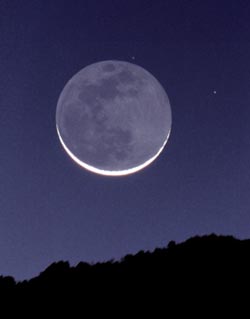
In Pearce, Arizona, Matt BenDaniel recorded the Moon at dawn on October 15, 2001, only 30.8 hours before new. He took the 4-second exposure on Kodak E200 film with a 130-millimeter Astro-Physics refractor at f/6.7.
Another new-Moon weekend has arrived, and that means astrophotographers will head for local hilltops in quest of the "old Moon in the young Moon's arms." The Moon is technically new when it passes the Sun at 8:18 a.m. Eastern Daylight Time on Monday, May 5th. So on Saturday morning before sunup, and on Tuesday evening after sundown, the thin crescent will be an especially inviting spectacle. And Tuesday's crescent will appear just a few degrees from Mercury.
But veteran Moon-and-planet watcher Robert C. Victor points out that this new Moon offers something quite special. Because the Moon is passing north of the Sun and is also at perigee, hence moving most rapidly along its orbit, there's a chance for North Americans to spot an ultrathin crescent Moon on Sunday morning in the east, and then again on Monday evening in the west — on consecutive days. Only a tiny handful of skilled observers have ever managed to see such "opposing crescents" before.
Clear skies and unblocked views of the horizon are crucial to success, of course. You also need to know exactly where in the sky the Moon will be, and when. Have binoculars handy — they can help! Without careful planning on your part, failure is almost guaranteed.
Victor points out that the Sun and Mercury can play important roles for skywatchers in the US and southern Canada this weekend:
(1) To prepare for glimpsing Sunday morning's crescent Moon, watch the sunrise on Saturday morning and note the time when the Sun has climbed 5° above the horizon. This tells you that on Sunday morning, some 60 minutes earlier, the Moon will also be 5° up and 1° or 2° to the right of where the Sun was.
(2) For the even-more-difficult thin crescent on Monday evening, check Mercury on Sunday evening. Follow Mercury in the western sky until its altitude has gone down to 4°. Then on Monday evening, about 50 to 55 minutes earlier, the Moon will be at almost exactly that same spot.
These rough guidelines may not be accurate enough. So Victor strongly recommends refining the times for your own location, using any planetarium software that gives the altitudes and azimuths of celestial bodies for your location.
"Folks in the East will have a very hard time seeing the young Moon on Monday evening," Victor warns. "For Boston and Miami, when the Sun is 5° down at 8:14 p.m. EDT, the Moon will be at nearly a record-young age of 11 hours 56 minutes."
For further details, check out the handy Abrams Planetarium Sky Calendar for May. My own articles in the February Sky & Telescope, page 72, and also here have more about the techniques and special conditions needed for spotting a very young Moon.
As an added inducement, this new Moon coincides with the peak of the Eta Aquarid meteor shower. So if you live south of latitude 35° N, keep an eye open for Eta Aquarids while you're preparing to look for the pre-dawn Moons on Saturday and Sunday.
 5
5
Comments
Random43
May 2, 2008 at 3:47 pm
How would this look in Seattle?
You must be logged in to post a comment.
Roger Sinnott
May 2, 2008 at 6:31 pm
In Seattle, the Sun will be 5 degrees up at 6:25 am PDT Saturday morning. On Sunday morning, the Moon will be 5 degrees up at 5:30 am PDT, 1.2 degrees to the right of where the Sun was. Good luck!
You must be logged in to post a comment.
Astromama
May 5, 2008 at 3:14 pm
If anyone got pictures, please post them and give us a URL. It's raining here in Texas. Thanks.
You must be logged in to post a comment.
Astromama
May 5, 2008 at 3:14 pm
If anyone got pictures, please post them and give us a URL. It's raining here in Texas. Thanks.
You must be logged in to post a comment.
Tom H
May 22, 2008 at 3:13 pm
Did anyone score a visual or a snapshot of the youngest cresent moon? We were clouded out in New York.
You must be logged in to post a comment.
You must be logged in to post a comment.